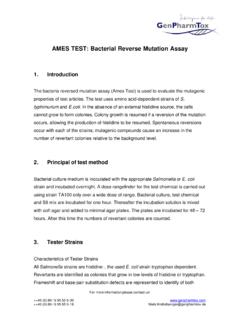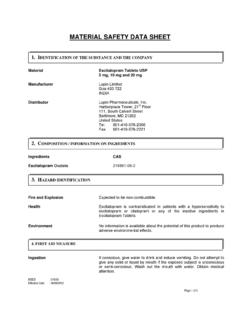Transcription of OECD GUIDELINE FOR TESTING OF CHEMICALS
1 471 Adopted:21st July 19971/11 OECD GUIDELINE FOR TESTING OF CHEMICALSB acterial Reverse mutation TestINTRODUCTION1. The bacterial reverse mutation test uses amino-acid requiring strains of Salmonellatyphimurium and Escherichia coli to detect point mutations, which involve substitution, addition ordeletion of one or a few DNA base pairs (1)(2)(3). The principle of this bacterial reverse mutationtest is that it detects mutations which revert mutations present in the test strains and restore thefunctional capability of the bacteria to synthesize an essential amino acid. The revertant bacteria aredetected by their ability to grow in the absence of the amino acid required by the parent test strain.
2 2. Point mutations are the cause of many human genetic diseases and there is substantialevidence that point mutations in oncogenes and tumour suppressor genes of somatic cells areinvolved in tumour formation in humans and experimental animals. The bacterial reverse mutationtest is rapid, inexpensive and relatively easy to perform. Many of the test strains have severalfeatures that make them more sensitive for the detection of mutations, including responsive DNAsequences at the reversion sites, increased cell permeability to large molecules and elimination ofDNA repair systems or enhancement of error-prone DNA repair processes. The specificity of the teststrains can provide some useful information on the types of mutations that are induced by genotoxicagents.
3 A very large data base of results for a wide variety of structures is available for bacterialreverse mutation tests and well-established methodologies have been developed for TESTING chemicalswith different physico- chemical properties, including volatile compounds. 3. Definitions used are set out in the CONSIDERATIONS4. The bacterial reverse mutation test utilises prokaryotic cells, which differ from mammaliancells in such factors as uptake, metabolism, chromosome structure and DNA repair processes. Testsconducted in vitro generally require the use of an exogenous source of metabolic activation. In vitrometabolic activation systems cannot mimic entirely the mammalian in vivo conditions.
4 The testtherefore does not provide direct information on the mutagenic and carcinogenic potency of asubstance in mammals. 5. The bacterial reverse mutation test is commonly employed as an initial screen for genotoxicactivity and, in particular, for point mutation -inducing activity. An extensive data base hasdemonstrated that many CHEMICALS that are positive in this test also exhibit mutagenic activity inother tests . There are examples of mutagenic agents which are not detected by this test; reasons forthese shortcomings can be ascribed to the specific nature of the endpoint detected, differences inmetabolic activation, or differences in bioavailability. On the other hand, factors which enhance thesensitivity of the bacterial reverse mutation test can lead to an overestimation of mutagenic activity.
5 471 OECD/OCDE2/116. The bacterial reverse mutation test may not be appropriate for the evaluation of certainclasses of CHEMICALS , for example highly bactericidal compounds ( certain antibiotics) and thosewhich are thought (or known) to interfere specifically with the mammalian cell replication system( some topoisomerase inhibitors and some nucleoside analogues). In such cases, mammalianmutation tests may be more appropriate. 7. Although many compounds that are positive in this test are mammalian carcinogens, thecorrelation is not absolute. It is dependent on chemical class and there are carcinogens that are notdetected by this test because they act through other, non-genotoxic mechanisms or mechanismsabsent in bacterial cells.
6 PRINCIPLE OF THE TEST METHOD8. Suspensions of bacterial cells are exposed to the test substance in the presence and in theabsence of an exogenous metabolic activation system. In the plate incorporation method, thesesuspensions are mixed with an overlay agar and plated immediately onto minimal medium. In thepreincubation method, the treatment mixture is incubated and then mixed with an overlay agar beforeplating onto minimal medium. For both techniques, after two or three days of incubation, revertantcolonies are counted and compared to the number of spontaneous revertant colonies on solventcontrol plates. 9. Several procedures for performing the bacterial reverse mutation test have been those commonly used are the plate incorporation method (1)(2)(3)(4), the preincubationmethod (2)(3)(5)(6)(7)(8), the fluctuation method (9)(10), and the suspension method (11).
7 Modifications for the TESTING of gases or vapours have been described (12). 10. The procedures described in this GUIDELINE pertain primarily to the plate incorporation andpreincubation methods. Either of them is acceptable for conducting experiments both with andwithout metabolic activation. Some compounds may be detected more efficiently using thepreincubation method. These compounds belong to chemical classes that include short chainaliphatic nitrosamines, divalent metals, aldehydes, azo-dyes and diazo compounds, pyrollizidinealkaloids, allyl compounds and nitro compounds (3). It is also recognised that certain classes ofmutagens are not always detected using standard procedures such as the plate incorporation methodor preincubation method.
8 These should be regarded as "special cases" and it is stronglyrecommended that alternative procedures should be used for their detection. The following "specialcases" could be identified (together with examples of procedures that could be used for theirdetection): azo-dyes and diazo compounds (3)(5)(6)(13), gases and volatile CHEMICALS (12)(14)(15)(16), and glycosides (17)(18). A deviation from the standard procedure needs to bescientifically OF THE METHODP reparationsBacteria11. Fresh cultures of bacteria should be grown up to the late exponential or early stationaryphase of growth (approximately 109 cells per ml). Cultures in late stationary phase should not beused.
9 It is essential that the cultures used in the experiment contain a high titre of viable titre may be demonstrated either from historical control data on growth curves, or in each assaythrough the determination of viable cell numbers by a plating 12. The recommended culture temperature is 37 C. 13. At least five strains of bacteria should be used. These should include four strains of (TA1535; TA1537 or TA97a or TA97; TA98; and TA100) that have been shown to bereliable and reproducibly responsive between laboratories. These four S. typhimurium strains haveGC base pairs at the primary reversion site and it is known that they may not detect certain oxidisingmutagens, cross-linking agents and hydrazines.
10 Such substances may be detected by WP2strains or S. typhimurium TA102 (19) which have an AT base pair at the primary reversion the recommended combination of strains is: typhimurium TA1535, typhimurium TA1537 or TA97 or TA97a, typhimurium TA98, typhimurium TA100, coli WP2 uvrA, or E. coli WP2 uvrA (pKM101), or S. typhimurium order to detect cross-linking mutagens it may be preferable to include TA102 or to add a DNArepair-proficient strain of [ WP2 or WP2 (pKM101).]14. Established procedures for stock culture preparation, marker verification and storage shouldbe used. The amino-acid requirement for growth should be demonstrated for each frozen stockculture preparation (histidine for S.)















